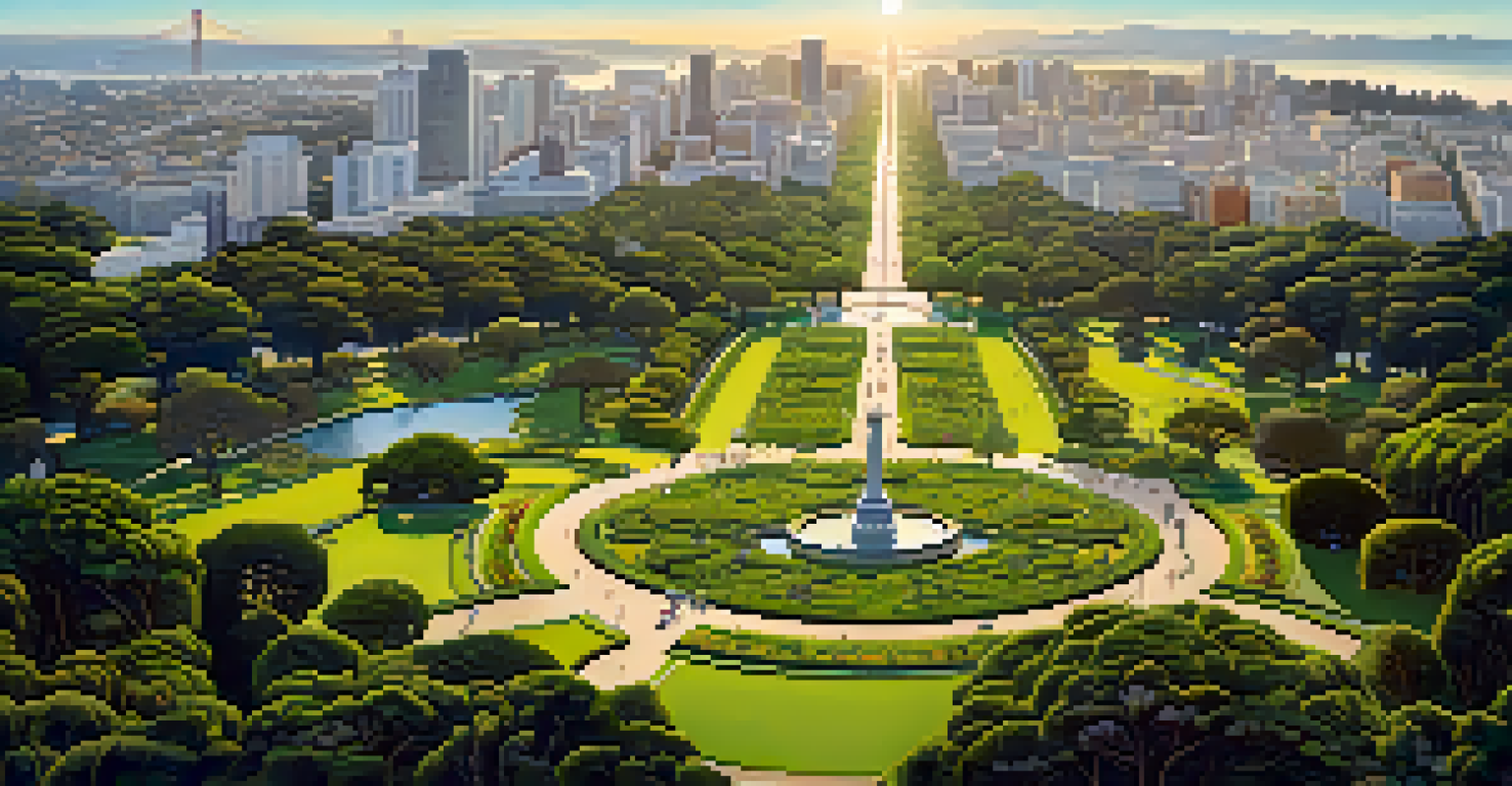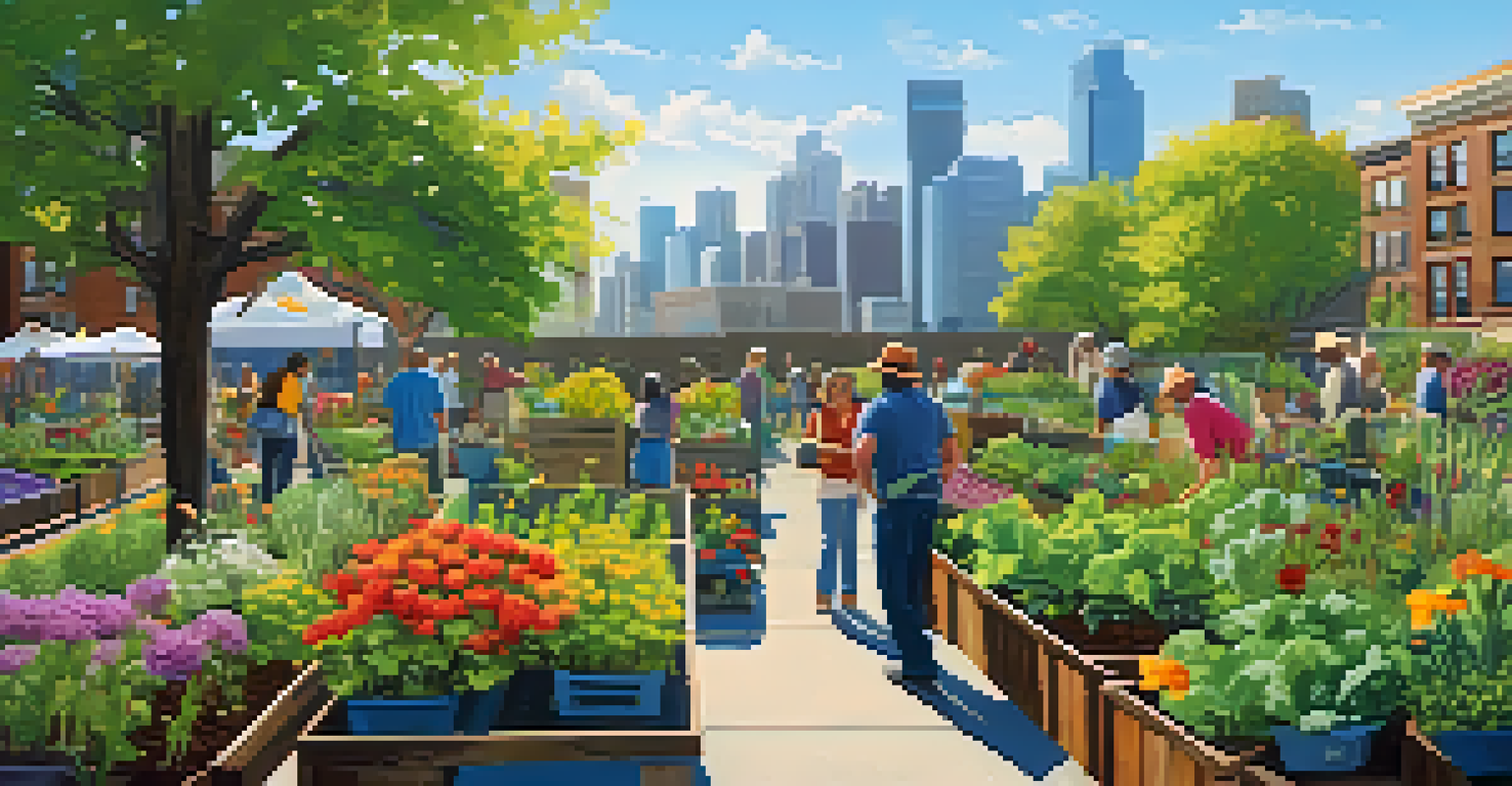Green Spaces: Essential for San Francisco's Urban Ecosystem

The Importance of Green Spaces in Urban Areas
Green spaces play a crucial role in urban environments by providing essential ecosystems. They act as lungs for cities, absorbing carbon dioxide and releasing oxygen, which improves air quality. Moreover, these areas offer a refuge for wildlife, helping to maintain biodiversity in an otherwise concrete backdrop.
The best time to plant a tree was twenty years ago. The second best time is now.
In cities like San Francisco, where the urban landscape is dense and bustling, green spaces are even more vital. They create a balance between nature and urbanization, allowing residents to reconnect with the environment. This connection not only enhances mental well-being but also fosters a sense of community among city dwellers.
Additionally, green spaces serve as recreational areas where people can exercise, relax, and socialize. Parks and gardens become gathering spots, encouraging physical activity and providing mental health benefits. In essence, they contribute significantly to the overall quality of life in urban settings.
San Francisco's Unique Urban Landscape
San Francisco's topography presents both challenges and opportunities for green spaces. Nestled between hills and the bay, the city has a unique geographical layout that influences where parks and gardens can thrive. This distinct landscape offers diverse ecosystems, from coastal areas to wooded hills, enhancing the variety of green spaces available.

The city's commitment to preserving and expanding green areas is evident in its numerous parks, including the iconic Golden Gate Park. This sprawling oasis offers a mix of gardens, lakes, and recreational facilities, attracting millions of visitors each year. It serves as a model for integrating nature into urban design, showcasing how green spaces can flourish even in densely populated areas.
Green Spaces Boost Urban Well-Being
Access to green spaces significantly enhances mental health, reduces stress, and fosters community connections.
Furthermore, San Francisco has implemented innovative solutions to create more green spaces, such as converting underutilized lots into community gardens. These initiatives not only beautify the neighborhood but also empower residents to take part in urban greening efforts, fostering a sense of ownership and pride.
Benefits of Green Spaces for Mental Health
Access to green spaces has been linked to improved mental health outcomes. Studies show that spending time in nature reduces stress, anxiety, and depression, making parks invaluable for urban residents. For many, these green havens provide a much-needed escape from the hustle and bustle of city life.
Nature does not hurry, yet everything is accomplished.
In San Francisco, local parks like Dolores Park and Alamo Square offer breathtaking views and opportunities for relaxation. These spaces become sanctuaries where individuals can unwind, practice mindfulness, or engage in social activities. The calming effect of nature not only enhances individual well-being but also strengthens community bonds.
Moreover, incorporating nature into daily routines can lead to healthier lifestyles. Whether it's jogging along a scenic path or enjoying a picnic with friends, green spaces encourage physical activity, which is essential for mental and emotional health. The connection between nature and well-being is undeniable, making green spaces even more crucial in urban settings.
Green Spaces and Climate Resilience
As cities face the challenges of climate change, green spaces emerge as essential components of urban resilience. They help mitigate the urban heat island effect by providing shade and cooling, which is critical during heatwaves. In San Francisco, where temperatures can spike, these areas are vital for maintaining comfortable living conditions.
Additionally, green spaces play a role in stormwater management. Parks and gardens absorb rainwater, reducing runoff and minimizing flooding risks. This natural approach to managing water resources is not only effective but also sustainable, showcasing how green spaces contribute to a healthier urban ecosystem.
Economic Benefits of Parks
Properties near green spaces often see increased value, while local businesses thrive from the foot traffic these areas generate.
Furthermore, urban greenery enhances biodiversity, allowing various species to thrive in city environments. This biodiversity helps create a more resilient ecosystem, capable of withstanding environmental stresses. In essence, investing in green spaces is an investment in a city's future sustainability.
Community Engagement Through Green Spaces
Green spaces serve as important venues for community engagement and social interaction. They host various events, from farmers' markets to outdoor concerts, bringing people together and fostering a sense of belonging. In cities like San Francisco, these gatherings promote local culture and encourage community participation.
Community gardens and volunteer initiatives also provide opportunities for residents to connect with one another. Working together to maintain these spaces cultivates relationships and strengthens neighborhood ties. This sense of collaboration can lead to increased civic pride and a shared commitment to preserving local environments.
Moreover, engaging the community in caring for green spaces ensures their longevity. When residents take an active role in maintaining parks and gardens, they are more likely to appreciate and protect these vital areas. This collaborative spirit not only enhances the urban landscape but also enriches the lives of those who inhabit it.
The Economic Impact of Green Spaces
Beyond their environmental and social benefits, green spaces also have significant economic implications. Properties located near parks and green areas tend to have higher real estate values. In San Francisco, this trend is evident, as neighborhoods with access to parks often attract more buyers and renters, boosting the local economy.
Moreover, parks can stimulate local businesses by drawing visitors and residents alike. Cafés, shops, and restaurants near popular green spaces often see increased foot traffic, contributing to their profitability. Events held in parks can further enhance local economic activity, creating a vibrant atmosphere that benefits everyone.
Climate Resilience Through Nature
Green spaces play a vital role in urban climate resilience by mitigating heat effects and managing stormwater.
Investing in green spaces can also lead to cost savings for cities. By reducing healthcare costs associated with poor mental and physical health, these areas provide long-term financial benefits. In this way, the economic advantages of green spaces reinforce their value as essential components of urban planning.
The Future of Green Spaces in San Francisco
Looking ahead, the future of green spaces in San Francisco looks promising. With increasing awareness of the importance of nature in urban settings, city planners are prioritizing the development of new parks and the enhancement of existing ones. This trend reflects a growing commitment to sustainability and community well-being.
Innovative projects, such as green roofs and vertical gardens, are gaining traction as solutions for maximizing limited space in urban areas. These creative approaches not only beautify the city but also contribute to environmental goals. As San Francisco continues to evolve, integrating more green infrastructure will be essential for maintaining its unique character.

Ultimately, fostering a culture that values and protects green spaces is crucial for the city's future. Engaging residents in discussions about urban green initiatives will help ensure that these spaces continue to thrive. By prioritizing green spaces, San Francisco can build a healthier, more vibrant urban ecosystem for generations to come.